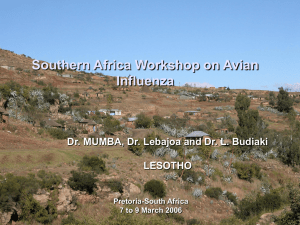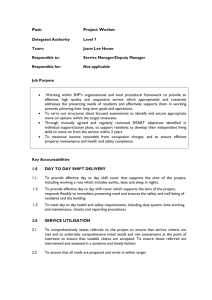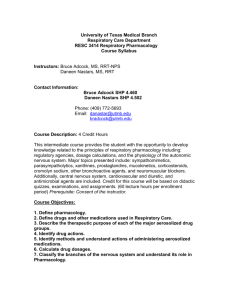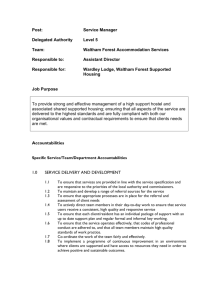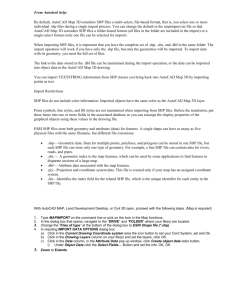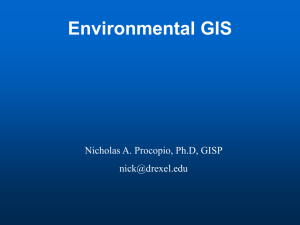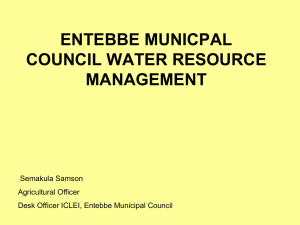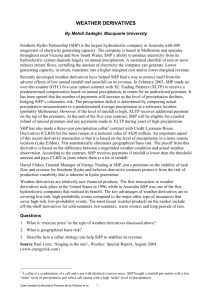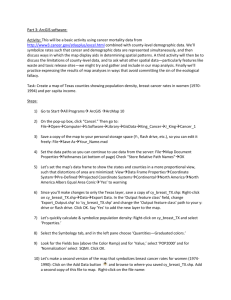Specifically, the following regions were used in GLMs as
advertisement
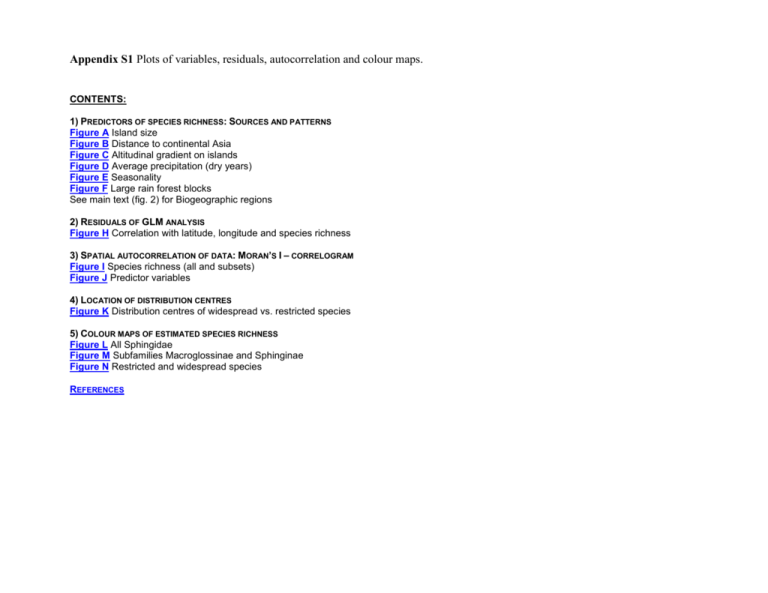
Appendix S1 Plots of variables, residuals, autocorrelation and colour maps. CONTENTS: 1) PREDICTORS OF SPECIES RICHNESS: SOURCES AND PATTERNS Figure A Island size Figure B Distance to continental Asia Figure C Altitudinal gradient on islands Figure D Average precipitation (dry years) Figure E Seasonality Figure F Large rain forest blocks See main text (fig. 2) for Biogeographic regions 2) RESIDUALS OF GLM ANALYSIS Figure H Correlation with latitude, longitude and species richness 3) SPATIAL AUTOCORRELATION OF DATA: MORAN’S I – CORRELOGRAM Figure I Species richness (all and subsets) Figure J Predictor variables 4) LOCATION OF DISTRIBUTION CENTRES Figure K Distribution centres of widespread vs. restricted species 5) COLOUR MAPS OF ESTIMATED SPECIES RICHNESS Figure L All Sphingidae Figure M Subfamilies Macroglossinae and Sphinginae Figure N Restricted and widespread species REFERENCES 1) PREDICTORS OF SPECIES RICHNESS: PATTERNS AND SOURCES 140 120 100 80 60 Est. species richness 40 20 0 0.001 0.010 0.100 1.000 10.000 100.000 Island size [10.000km2] Figure A Log-scaled island areas and estimated species richness of all Sphingidae on 114 islands. Island areas were calculated from the world map in ArcView 3.2a (2000), using an extension of Hooge et al. (1999). Back to Content 140 120 100 80 60 Est. species richness 40 20 0 0 1000 2000 3000 4000 5000 6000 7000 8000 Distance to continental Asia [km] Figure B Distance to continental Asia and estimated species richness of all Sphingidae on 114 islands. The closest distances between islands and the coast of Southeast-Asia were calculated with a program by Hooge et al. (1999), using a UTM (zone 50) projection of the world map in ArcView 3.2a (2000). Back to Content 140 120 100 80 60 Est. species richness 40 20 0 0 500 1000 1500 2000 2500 3000 3500 Elevational gradient [m] Figure C Altitudinal gradient on islands and estimated species richness of all Sphingidae on 114 islands. Gradients were measured as the highest altitude class (as evident from the graph) on the 3D-world map 2.0 (http://www.longgame.com/). I.e., assignment to the class “1000” represents islands with mountains ≥1000m, but less than 2000m. Due to the resolution of the map, exceedingly high peaks (e.g. Puncak Jaya >5000m in New Guinea) are not covered by data. Back to Content 140 120 100 80 60 Est. species richness 40 20 0 0 1000 2000 3000 4000 5000 6000 Average rainfall in dry years [mm] Figure D Average precipitation in dry years and estimated species richness of all Sphingidae on 114 islands. Precipitation data were taken from a map on Asian climate available at http://www.esri.com/, using the highest rainfall-category within an island. The alternatively available data for the relatively wet years did not result in a substantially different pattern. Back to Content 90 80 70 60 50 40 30 Est. species richness 20 10 0 Semi-evergreen Evergreen Mean Mean±SE Mean±SD Seasonality Figure E Seasonality of 114 islands was assessed from a map of large-scale vegetation zones (available at http://www.esri.com/), consisting largely of “evergreen forest” and “semi-evergreen forest” in our study region. Minor vegetation types, such as ‘interzonals’ (e.g. river floodplains) or savannahs (in southern New Guinea) were ignored. The data provide mainly a distinction between the perhumid islands and those with monsoon-seasonality in the northern parts of the Philippines and the Lesser Sunda Islands. If different zones occurred within one island (e.g. West Java vs. Central and East Java) we assigned the “evergreen” climate, as we know of species likely to be limited by drought, but not viceversa. Back to Content 120 100 80 60 40 Est. species richness 20 Mean Mean±SE Mean±SD 0 No rainforest Rainforest Figure F The presence or absence of large rain forest blocks was mainly assessed from maps in Monk et al. (1997) and Stibig et al. (2002). Back to Content 2) RESIDUALS OF GLM ANALYSIS r2 <0.001 p = 0.83 0 5 10 15 20 25 170 Longitude [o] 160 150 140 130 120 110 100 Residuals 30 20 10 0 -10 -20 -30 -40 r2 <0.001 p = 0.91 90 Latitude [o] 30 20 10 0 -10 -20 -30 -40 80 Residuals Residuals 30 20 10 0 -10 -20 -30 -40 -15 -10 -5 r2 = 0.26, p <0.001 0 20 40 60 80 100 120 140 Est. species richness Figure H Correlations of GLM residuals (for all Sphingidae) with latitude, longitude and sphingid species richness. There is no obvious geographic pattern in residuals, but the model consistently overestimates species-poor islands, whereas it underestimates species-rich islands. Back to Content 3) SPATIAL AUTOCORRELATION OF DATA: MORAN’S I – CORRELOGRAMS 1.0 0.5 1.0 All Sphingidae 0.5 1.0 Subf amily Macroglossinae 1.0 Subf amily Smerinthinae 0.5 0.5 0.0 0.0 0.0 0.0 -0.5 -0.5 -0.5 -0.5 -1.0 -1.0 500 1500 2500 1000 2000 -1.0 500 1500 2500 1000 2000 1.0 Moran's I 0.5 -1.0 500 1500 2500 1000 2000 1.0 Restricted (lower 25%) 0.0 1.0 0.5 Medium-restricted (25-50%) 0.0 -0.5 -0.5 -1.0 -1.0 500 1500 2500 1000 2000 500 1500 2500 1000 2000 1.0 Medium-widespread (50-75%) 0.5 0.5 0.0 0.0 -0.5 -0.5 -1.0 500 1500 2500 1000 2000 Subf amily Sphinginae Widespread (upper 25%) -1.0 500 1500 2500 1000 2000 Distance [km] 500 1500 2500 1000 2000 p <0.05 Non-sign. Figure I Correlograms of Moran’s I as a measure of spatial autocorrelation of sphingid species richness (complete and all subsets). The smallest spatial scale of analysis, 500 km, is approximately four times the median of an island’s nearest neighbour; the maximum scale of 2,500 km represents ca. 30% of the total longitudinal and >60% of the total latitudinal extent of the study region. Moran’s I were calculated with Rookcase (Sawada 1999), using UTM coordinates of island centres. Significance tests are Bonferroni-corrected. Back to Content 1.0 0.5 Biogeogr. region 0.0 1.0 1.0 0.5 0.5 0.0 -0.5 -0.5 -1.0 1.0 0.5 0.0 Distance to Asia -1.0 500 1000 1500 2000 2500 -0.5 -1.0 500 1000 1500 2000 2500 1.0 Altitudinal range 0.5 500 1000 1500 2000 2500 1.0 Precipitation 0.5 0.0 0.0 0.0 -0.5 -0.5 -0.5 -1.0 -1.0 Moran's I 500 1000 1500 2000 2500 log(Island area) Seasonality -1.0 500 1000 1500 2000 2500 500 1000 1500 2000 2500 1.0 0.5 0.0 -0.5 Rainf orests -1.0 500 1000 1500 2000 2500 Distance [km] Figure J Correlograms of Moran’s I as a measure of spatial autocorrelation of interval-scaled predictor variables. The smallest spatial scale of analysis, 500 km, is approximately four times the median of an island’s nearest neighbour; the maximum scale of 2,500 km represents ca. 30% of the total longitudinal and >60% of the total latitudinal extent of the study region. Moran’s I were calculated with Rookcase (Sawada 1999), using UTM coordinates of island centres. Significance tests are Bonferroni-corrected. Back to Content 4) LOCATION OF DISTRIBUTION CENTRES S # S # S # S # S # S # S # S # 0 S # S # S# # S S # S # # S # S S # S # S # S # S # S # S # S # # # S S# S S # # S S # # S# S # S # S S # # S# S# S # S# S S # # S S # S# # S # S # S S # S # S # S# # S # S S# # S S# # S S # # S # S # S S # S # # S S # S # S # # S# S S # # S S # S # S# # S S# # S S # S # S# # S S # S # # S # S# S S # S# # S# S S # S# # S S# # S S # # S S # # S S # ## S S S # # S # S # S S # # S Restricted Widespread Wallace's line Weber's line 1000 2000 S # S # S # # S S # S# # S S # S S # # # S S # ## S S S# # S S # S # S # S # 3000 4000 Kilometers Figure K Location of distribution centres for widespread and restricted range size quartiles of Malesian species (map in geographic projection). Distribution centres were estimated as means of latitudinal and longitudinal extremes (this is far easier than calculating centroids for fragmented ranges, whereas a kernel-approach on original data would be heavily biased by the popularity of sampling sites). Distribution centres of widespread species are clearly more west than those of restricted species (see main text for statistical testing). Back to Content 5) COLOUR MAPS OF ESTIMATED SPECIES RICHNESS Sphingidae - species richness 141-160 128-140 110-127 92-109 74-91 57-73 39-56 21-38 3-20 Figure L Species richness of all Sphingidae species in Southeast Asia. Patterns were derived from overlaying distribution estimates of all species (see Beck & Kitching 2004 for details). Note that patterns within islands (e.g. higher species richness in the mountainous regions of Borneo and New Guinea) are ignored in the analysis, where always island totals were used. Back to Content MACROGLOSSINAE Estimated species richness 72-88 54-71 36-53 18-35 2-17 N W E S 0 1000 2000 3000 4000 Kilometers Malaita.shp Leyte.shp Leti.shp Lembata.shp Lavongai.shp Larat.shp Kulambangra.shp Komodo.shp Kelang.shp Kai.shp Jolo.shp Java.shp Isa bel.shp Timor.shp Ticao.shp Tawitawi.shp Tanimbar.shp Sumbawa.shp Sumba.shp Sumatra.shp SMERINTHINAE Estimated species richness 30-34 22-29 15-21 7-14 1-6 N W E S 0 1000 2000 3000 4000 Kilometers Ferguson.shp Dyau l.shp Duma ran.shp Dinagat.shp Damp ier.shp Dammer.shp Choiseul.shp Cebu.shp Catanduanes.shp Calayan.shp Calamian.shp C de mindanao.shp C de luzon.shp Buton.shp Buru.shp Figure M Estimated species richness for the subfamilies Macroglossinae and Smerinthinae. Data for the Sphinginae is not shown as this subfamily is to poor in species to exhibit conclusive patterns. Back to Content Simeuloe.shp Sibuyan.shp Shortland.shp Sermatta.shp RESTRICTED SPECIES Estimated species richness 20 8-9 6-7 4-5 2-3 0-1 N W E S 0 1000 2000 3000 4000 Kilometers Leyte.shp Leti.shp Lembata.shp Lavongai.shp Larat.shp Kulambangra.shp Komodo.shp Kelang.shp Kai.shp Burias.shp Bougainville.shp Borneo.shp WIDESPREAD SPECIES Estimated species richness 57-70 43-56 29-42 15-28 1-14 N W E S 0 1000 2000 3000 4000 Kilometers Figure N Estimated species richness for restricted and widespread species, defined as lower and upper quartile of species’ global distribution rank (see main text for details). Back to Content REFERENCES ArcView GIS 3.2a (2000) Computer program and manual. Environmental Systems Research Institute (ESRI), Redlands (California). http://www.esri.com. Beck, J. & Kitching, I.J. (2004) The Sphingidae of Southeast-Asia, incl. New guinea and the Solomon Islands. http://www.sphingidae-sea.biozentrum.uni-wuerzburg.de Hall, R. (1998) The plate tectonics of Cenozoic SE Asia and the distribution of land and sea. Biogeography and geological evolution of South East Asia (ed. by R. Hall & J.D. Holloway), pp 99-131. Backhuys, Leiden. Holloway, J.D. (1987) Lepidoptera patterns involving Sulawesi: what do they indicate of past geography? Biogeographical evolution of the Malay archipelago (ed. by T.C. Whitmore), pp 103-118. Clarendon Press, Oxford. Holloway, J.D. (2003) Biological images of geological history: through a glass darkly or brightly face to face? Journal of Biogeography, 30, 165-179. Hooge, P. N,. Eichenlaub, W. & Solomon, E. (1999) The animal movement program. USGS, Alaska Biological Science Center. Monk, K.A., de Frete, Y., Reksodiharjo-Lilley, G. (1997) The ecology of Nusa Tenggara and Maluku. The Ecology of Indonesia series V. Periplus Editions Ltd., Hong Kong. Sawada, M. (1999) Rookcase: an Excel 97/2000 Visual Basic (VB) Add-In for exploring global and local spatial autocorrelation. Bulletin of the Ecological Society of America, 80, 231-234. Stibig, H. J., Beuchle, R. & Janvier, P. (2002) Forest cover maps of insular Southeast-Asia 1:5500000 derived from SPOT-VEGETATION satellite images. TREES Publication Series D: Thematic outputs No. 3. European Commission Joint Research Centre. van Welzen, P.C., Turner, H. & Hovenkamp, P. (2005) Historical biogeography of Southeast-Asia and the West Pacific, or the generality of unrooted area networks as historical biogeographic hypotheses. Journal of Biogeography, 30, 181-192. Back to Content
